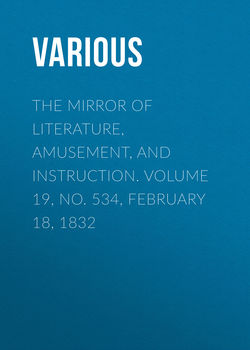The Mirror of Literature, Amusement, and Instruction. Volume 19, No. 534, February 18, 1832

Реклама. ООО «ЛитРес», ИНН: 7719571260.
Оглавление
Various. The Mirror of Literature, Amusement, and Instruction. Volume 19, No. 534, February 18, 1832
OUR LADY'S CHAPEL,
ST. SAVIOUR, SOUTHWARK
NIGHT-MARE
LACONICS
STANZAS TO THE SPIRIT OF MORNING
NOTES OF A READER
BRITAIN'S HISTORICAL DRAMA
CHORUS OF BARDS
SNATCHES FROM EUGENE ARAM
SPIRIT OF THE PUBLIC JOURNALS
A DAY AT LULWORTH. 6
COLONEL BRERETON
SELECT BIOGRAPHY
THE LATE MR. MUNDEN
THE SELECTOR; AND LITERARY NOTICES OF NEW WORKS
MEMOIRS OF SIR RALPH ESHER,
THE GATHERER
AN ODD STORY
Отрывок из книги
The Engraving represents the interior of the Virgin Mary's Chapel, commonly called the Lady Chapel, and appended to the ancient collegiate church of St. Saviour, Southwark. The exterior view of the Chapel will be found in No. 456 of The Mirror. About eighteen months since part of the western side of the High-street was removed for the approach to the New London Bridge, when this Chapel was opened to view; but its dilapidated appearance was rather calculated to interest antiquarian than public curiosity. The London Bridge Committee recommended the parishioners of St. Saviour to cause the Chapel to be pulled down, and their selfish suggestion would have been complied with, had not some enlightened and public-spirited individuals stepped forth to frustrate the levellers. The parishioners now became two parties. One contended for the restoration of the Chapel, as "one of the most chaste and elegant specimens of early pointed architecture of the thirteenth century of which this country can boast." The levellers, whose muckworm minds, and love of the arts is only shown in that of money-getting—maintained that the demolition of the Chapel would be "a pecuniary saving;" but theirs was a penny-wise and pound-foolish spirit; for, by removing the Chapel, a greater expense would be incurred than in its restoration. The folks could not understand plain figures, and so resolved to take the sense and nonsense of the parish, and the subject has been decided by a majority of 240 in favour of repairing the Chapel. The funds for this purpose, it should be understood, were in course of provision by public subscription, so that the blindness of party zeal threatened to reject a special advantage—the public would find the money if they would allow the Chapel to remain—whereas, had the demolition taken place, the parishioners must themselves have defrayed the consequent expenses. Historians loudly condemn the royal and noble thieves who plundered the Coliseum and the Pantheon to build palaces, yet there are men in our times, who would, if they could, take Dr. Johnson's hint to pound St. Paul's Church into atoms, and with it macadamize their roads; or fetch it away by piecemeal to build bridges with its stones, and saw up its marble monuments into chimneypieces.
The church of St. Saviour is built in the form of a cathedral, with a nave, side aisles, transepts, a choir, with its side aisles; and the chapel of St. John, which now forms the vestry, and the chapel of the Virgin Mary, or Our Lady. To the east end of the latter there has since been added a small chapel, called the Bishop's Chapel. Another chapel, (of St. Mary Magdalen,) was also connected with the south aisle of the church. The parishioners seem to have hitherto neglected the Lady Chapel, and to have shown their cupidity in ages long past. Through the influence of Dr. Gardiner, Bishop of Winchester, they were allowed to purchase the church of that wholesale sin-salesman, Henry VIII.; but after the parish had obtained the grant of the church, they let the Lady Chapel to one Wyat, a baker, who converted it into a bake-house. He stopped up the two doors which communicated with the aisles of the church, and the two which opened into the chancel, and which, though visible, still remain masoned up. 1 In 1607, Mr. Henry Wilson, tenant of the Chapel of the Holy Virgin, found himself inconvenienced by a tomb "of a certain cade," and applied to the vestry for its removal, which was very "friendly" consented to, "making the place up again in any reasonable sort." 2 In this state it continued till the year 1624, when the vestry restored it to its original condition, at an expense of two hundred pounds. "More than that sum," observes the Rev. Mr. Nightingale, "I should conceive would now be required to repair this venerable part of St. Saviour's Church in such a manner as is absolutely necessary. The pillars have in a great degree lost their perpendicular position: the mouldings and mullions of the windows are distorted in the most shameful manner; the walls are rapidly hastening to their final decay; and the whole place appears to be destined to become once more the resort of hogs and vermin of every description. That this should be the case is a great disgrace to the parish, and an insult to the diocese, in which St. Saviour's Church holds so conspicuous a character." 3
.....
The man who feels he is in the right is seldom dogmatical, for truth is always calm and requires not violence to enforce her arguments: we should desist from the contest the moment we feel anxious about victory, because that anxiety must make us less particular about the truth.
Quickness of intellect is no proof of solidity: the deepest rivers flow on the smoothest.
.....